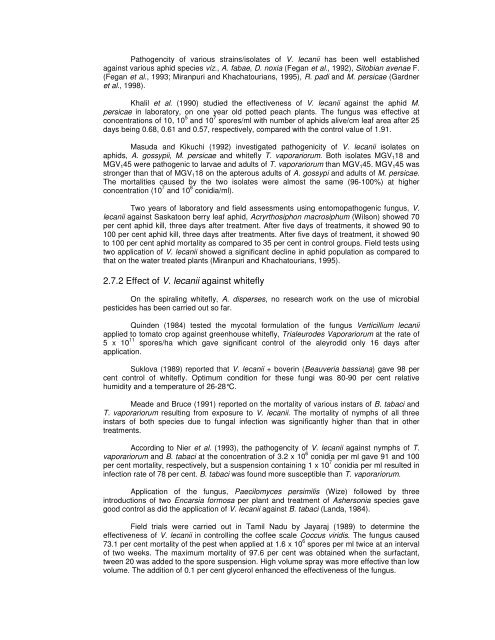ISOLATION AND CHARACTERIZATION OF ENTOMOPATHOGENIC ...
ISOLATION AND CHARACTERIZATION OF ENTOMOPATHOGENIC ...
ISOLATION AND CHARACTERIZATION OF ENTOMOPATHOGENIC ...
Create successful ePaper yourself
Turn your PDF publications into a flip-book with our unique Google optimized e-Paper software.
Pathogencity of various strains/isolates of V. lecanii has been well established<br />
against various aphid species viz., A. fabae, D. noxia (Fegan et al., 1992), Sitobian avenae F.<br />
(Fegan et al., 1993; Miranpuri and Khachatourians, 1995), R. padi and M. persicae (Gardner<br />
et al., 1998).<br />
Khalil et al. (1990) studied the effectiveness of V. lecanii against the aphid M.<br />
persicae in laboratory, on one year old potted peach plants. The fungus was effective at<br />
concentrations of 10, 10 5 and 10 7 spores/ml with number of aphids alive/cm leaf area after 25<br />
days being 0.68, 0.61 and 0.57, respectively, compared with the control value of 1.91.<br />
Masuda and Kikuchi (1992) investigated pathogenicity of V. lecanii isolates on<br />
aphids, A. gossypii, M. persicae and whitefly T. vaporariorum. Both isolates MGV118 and<br />
MGV 145 were pathogenic to larvae and adults of T. vaporariorum than MGV 145. MGV 145 was<br />
stronger than that of MGV118 on the apterous adults of A. gossypi and adults of M. persicae.<br />
The mortalities caused by the two isolates were almost the same (96-100%) at higher<br />
concentration (10 7 and 10 8 conidia/ml).<br />
Two years of laboratory and field assessments using entomopathogenic fungus, V.<br />
lecanii against Saskatoon berry leaf aphid, Acryrthosiphon macrosiphum (Wilson) showed 70<br />
per cent aphid kill, three days after treatment. After five days of treatments, it showed 90 to<br />
100 per cent aphid kill, three days after treatments. After five days of treatment, it showed 90<br />
to 100 per cent aphid mortality as compared to 35 per cent in control groups. Field tests using<br />
two application of V. lecanii showed a significant decline in aphid population as compared to<br />
that on the water treated plants (Miranpuri and Khachatourians, 1995).<br />
2.7.2 Effect of V. lecanii against whitefly<br />
On the spiraling whitefly, A. disperses, no research work on the use of microbial<br />
pesticides has been carried out so far.<br />
Quinden (1984) tested the mycotal formulation of the fungus Verticillium lecanii<br />
applied to tomato crop against greenhouse whitefly, Trialeurodes Vaporariorum at the rate of<br />
5 x 10 11 spores/ha which gave significant control of the aleyrodid only 16 days after<br />
application.<br />
Suklova (1989) reported that V. lecanii + boverin (Beauveria bassiana) gave 98 per<br />
cent control of whitefly. Optimum condition for these fungi was 80-90 per cent relative<br />
humidity and a temperature of 26-28°C.<br />
Meade and Bruce (1991) reported on the mortality of various instars of B. tabaci and<br />
T. vaporariorum resulting from exposure to V. lecanii. The mortality of nymphs of all three<br />
instars of both species due to fungal infection was significantly higher than that in other<br />
treatments.<br />
According to Nier et al. (1993), the pathogencity of V. lecanii against nymphs of T.<br />
vaporariorum and B. tabaci at the concentration of 3.2 x 10 6 conidia per ml gave 91 and 100<br />
per cent mortality, respectively, but a suspension containing 1 x 10 7 conidia per ml resulted in<br />
infection rate of 78 per cent. B. tabaci was found more susceptible than T. vaporariorum.<br />
Application of the fungus, Paecilomyces persimilis (Wize) followed by three<br />
introductions of two Encarsia formosa per plant and treatment of Ashersonia species gave<br />
good control as did the application of V. lecanii against B. tabaci (Landa, 1984).<br />
Field trials were carried out in Tamil Nadu by Jayaraj (1989) to determine the<br />
effectiveness of V. lecanii in controlling the coffee scale Coccus viridis. The fungus caused<br />
73.1 per cent mortality of the pest when applied at 1.6 x 10 6 spores per ml twice at an interval<br />
of two weeks. The maximum mortality of 97.6 per cent was obtained when the surfactant,<br />
tween 20 was added to the spore suspension. High volume spray was more effective than low<br />
volume. The addition of 0.1 per cent glycerol enhanced the effectiveness of the fungus.
















